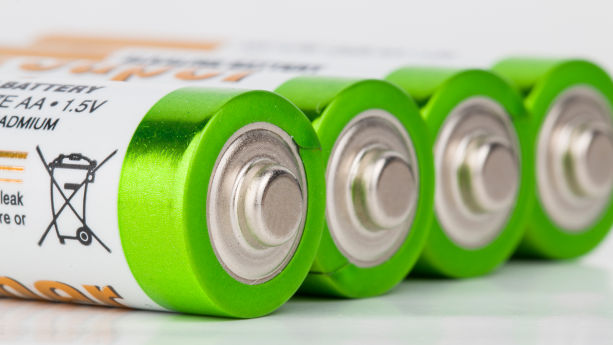
Planning to import batteries to the EU? In this guide, we introduce what importers and manufacturers should know about the Battery Directive, including restricted substances, labeling requirements, registration process, collection and recycling scheme, and testing companies providing product compliance services.
Content Overview

FREE CONSULTATION CALL (US, EU & UK)
- Request a free 30-minute call with Ivan Malloci to learn how we can help you with:
- Find product requirements
- Certification and labeling
- Lab testing
What is the Battery Directive?
The Battery Directive establishes rules on batteries and accumulators regarding the subject of hazardous substance limits, labeling, waste collection, treatment, recycling, and disposal. You can find the directive on this page.
This Directive covers batteries and accumulators of all shapes, volumes, weights, material composition, and usage – excluding batteries for military and aerospace purposes.
Further, the Battery Directive is implemented by each member state through its national legislative body and national battery law. Therefore, there can be some slight variations on the battery requirements among each member state, mostly presented in the registration procedures and collection schemes.
Products covered by the Battery Directive
The Battery Directive covers portables batteries, industrial and automobile batteries, and accumulators. Below we provide some examples of batteries that are under the scope of the Battery Directive:
- Lithium-ion batteries
- Lithium metal battery
- Alkaline battery
- Nickel cadmium batteries
- Nickel metal hydride batteries
- Button-cell batteries
- Sealed lead-acid batteries
Substance Restrictions
The Battery Directive restrains the content of mercury, cadmium, and their compounds in various types of batteries. Below follows an overview of restricted substances.
Mercury
The Battery Directive states that batteries and accumulators that contain more than 0.0005% by weight of mercury or mercury compounds are prohibited to be placed in the EU market.
Mercury batteries were once popularly used to power a wide range of consumer electronic products such as watches, radios, and remote controls.
However, the improper disposal of mercury batteries can cause serious environmental issues such as the pollution of water bodies, soil, and air. Exposure to mercury can cause skin irritation, kidney poisoning, and memory recession, therefore mercury batteries were gradually phased out in the market in recent years.
Cadmium
Portable batteries and accumulators that contain more than 0.002% by weight of cadmium or cadmium compounds are prohibited to be marketed and distributed in the EU, with the following exemptions:
- Emergency and alarm systems
- Medical equipment
- Cordless power tools
Portable nickel-cadmium battery is a type of rechargeable battery that was popular in the household electronic markets before the 2000s, for instance for products such as remote controllers and clocks. However, the improper disposal of cadmium in batteries continues to contaminate the environment and cause critical health effects to the kidneys system of humans and other mammals.
Under the Battery Directive, Nickel-cadmium batteries were largely banned in the EU market after 2006.
Lead
Even though lead content in batteries is not restricted, any battery that contains more than 0.004% of lead, must include the symbol “Pb” on its labeling. You can learn more about this in the “Labeling Requirements” section of this guide.
Registration and Recycling Requirements
The Battery Directive is implemented by the national authorities of the member states. This means that there could be slight variations in the requirements among different countries in the EU.
Importers and manufacturers of batteries should register with the national bodies of the destination market – or markets, – and comply with the relevant national battery laws.
Registration Procedure
In this section, we briefly cover the registration procedure for battery importers or manufacturers looking to place their products in the EU.
Registration Information
Importers and manufacturers of batteries should register their batteries with the responsible national organizations. For example, if you want to place your batteries or accumulators in France, you need to register with the Ministry of Ecological Transition and comply with article R.543 of the French Environmental Code.
If your destination market is Germany, then you should register with the Federal Ministry for the Environment and comply with the BattG-Melderegister (Batteries Act) of Germany.
Importers and manufacturers of batteries must provide the relevant information to the registration bodies, which might include the following:
a. Company name and brand name
b. Company address
c. Contact number, email address, and contact person
d. Battery type (ie. portable, industrial, or automotive batteries)
e. Explanation on how the importer or manufacturer complies with the requirements of the authorities (ie. test report
f. Date of the application for registration
g. National identification code of the importer or manufacturer, including European tax number or national tax number
h. A declaration stating that the provided information is genuine
Note that, as already mentioned, the procedure and required information might be different according to the country. Below you find links to the battery registration pages for different member states of the EU:
Also, in many countries, such as Sweden, companies that sell batteries directly to consumers (B2C) from another country might make registration voluntary – but are not obliged to do so.
Fees
National bodies may charge a certain handing fee or registration fee from the importer or manufacturer. We suggest you contact the national body of the destination market for further information about the charge.
Here we provide some examples:
- Germany: 143 Euro
- Sweden: 1,000 SEK (about 98 Euro at the time of writing)
- Ireland: From 75 Euro – the fee increases according to the company’s turnover
Certificate of Registration
After reviewing and confirming that the submitted information is valid, the national body issues a notification confirmation with the registration number on the file, or simply send out a registration number with issuing date, depending on the practice of individual national bodies.
Reporting and Collection Schemes
The Battery Directive requires national authorities to implement collection schemes on a national level. Currently, the minimum collection rate for each member state is 45%.
Some member states might set up a more aggressive collection scheme and have achieved a higher battery collection rate, such as Belgium (71%) and Luxembourg (63%).
The EU minimum collection rate might be subject to change in the future progressing with the stricter requirement for environmental protection, which could lead to more cost on the recycling system.
Importers and manufacturers are required to communicate the number of batteries placed into the market and the number of batteries collected, every year. For example, in Sweden, the deadline for providing this information is the 31st of march each year.
Labeling Requirements
The Battery Directive requires batteries and accumulators, despite the types, and weight must bear separate collection symbol. Other additional symbols may be required to be used depending on the content of the battery.
Separate Collection Symbol

The Battery Directive requires that all batteries and accumulators must bear the separate collection symbol, which is an icon of a crossed-out wheeled bin. The separate collection symbol is to remind the consumers that batteries should not be disposed to the garbage bins that collect regular wastes.
The size of the separate collection symbol must cover more than 3% of the area of the largest side of the battery, accumulator, or battery pack. The maximum coverage size should not be over 5×5 cm.
For cylindrical cells, the size of the separate collection must occupy more than 1.5% of the surface area, with the maximum size to be no more than 5×5 cm.
The separate collection symbol must be printed on the packaging when the surface area of the battery is smaller than 0.5×0.5 cm. In this case, the separate collection symbol must be at least 1×1 cm large.
Substance Symbol
As already explained, most of the batteries can’t be placed on the market if they contain mercury or cadmium above the threshold limit (i.e. more than 0.0005% for mercury, and more than 0.002% cadmium).
However, when the battery is exempted from this restriction – for instance, batteries for alarm systems – and it contains mercury or cadmium above their threshold limit, they should bear the chemical symbol of mercury of cadmium “Hg”, or “Cd”, respectively – beneath the separate collection symbol.
Also, according to the directive, lead content in batteries is no longer restricted. However, batteries that contain more than 0.004% of lead must be marked with the chemical symbol of lead: “Pb”.
The symbol indicating the substance must be printed below the separate collection symbol and cover an area of at least 1/4 of the area covered by the separate collection symbol.
Battery Capacity
The Battery Directive requires that all batteries must have a sign or symbol indicating the capacity. However, the metric standard is not given by the directive. There could be a variance of capacity indication for batteries, such as V, mAh, or Ah.
Lab Testing
Some third-party lab agencies provide comprehensive compliance-assurance services for battery importers and manufacturers. These services include:
- Battery testing
- Safety data sheets
- Product labeling and documentation
- Registration with relevant national bodies
- Practicing collection and recycling schemes
Labs that provide all or partially the above-mentioned services:
- Intertek
- SGS
- Tuv Rheinland
- Eurofins
Compliance Risks
Some batteries manufactured primarily for other markets outside the EU may still contain mercury and cadmium above the set limits. That said, Sony, Samsung, and other major battery brands generally ensure that all their products are compliant with EU regulations.
One option could therefore be to ensure that your products include containing brand name batteries that are compliant with the EU battery directive.
















Hi all,, why is 18650 prohibited/restricted,is the chemical ? or size ?
i have another question, after answer. many thanks in advance. Tony
Hello, If the battery is inside an EEE, is it still required to comply with this directive and have the separate collection symbol as the EEE will eventually be covered by WEEE with Wheelie Bin sticker.
Hello
I have a question regarding lithium batteries – Most of the requirements apply for industrial batteries with internal storage and a capacity above 2 kWh.
For battery packs how do we measure the capacity? Each battery individually or the capacity of the whole pack?
Thanks,
Cleo